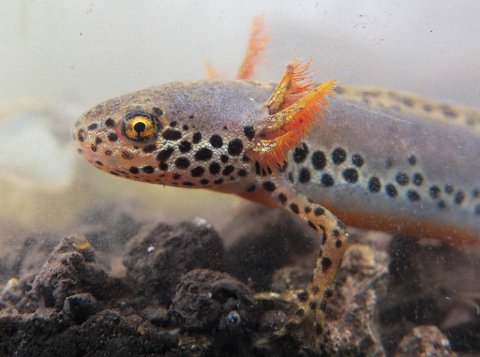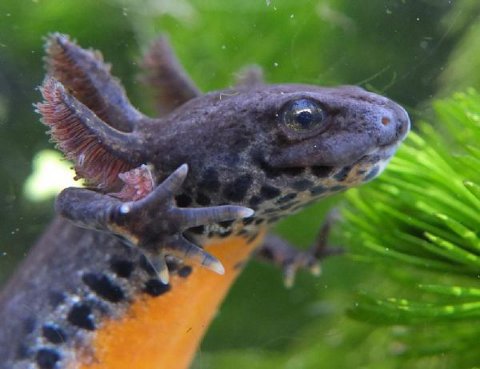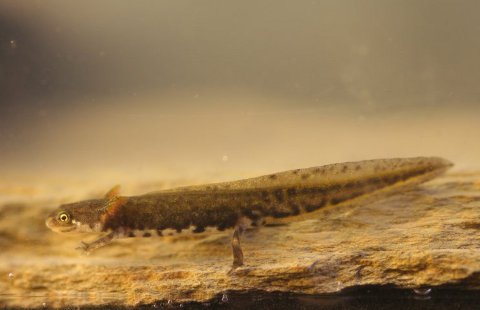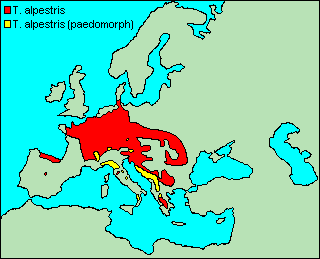
This page is a work-in-progress regarding paedomorphosis in Triturus sensu lato.

Neotenous male Triturus (=Mesotriton, Ichthyosaura) alpestris. Photo by Will Atkins.

Neotenous female Triturus (=Mesotriton, Ichthyosaura) alpestris. Photo by Will Atkins.

Neotenous female Triturus (= Lissotriton) italicus.
NEOTENY, PAEDOMORPHOSIS AND PROGENESIS
Newts showing both adult and larval features are often referred to as 'neotenous' or 'paedomorphic'. Gould (1977) defines three terms relating to this phenomenon:
Neoteny has also been subdivided into "partial" and "total" neoteny (e.g. Ingram, 1929). "Total neoteny" refers to individuals that reach sexual maturity while retaining larval features, with "partial neoteny" referring to those in which the larval stage is prolonged.
In addition, "facultative neoteny" or "facultative paedomorphosis" describes animals which are able to metamorphose under certain conditions; "obligate neoteny" or "obligate paedomorphosis" describes animals which are unable to metamorphose under any condition [REF].
OVERWINTERING
Overwintering appears to be common in European newt larvae. Bell & Lawton (1975) estimated that 38% of all metamorphs in a population of T. vulgaris in Oxfordshire had overwintered before metamorphosis. They suggest that any larvae in this population that fail to reach 35mm in length before mid-September will overwinter, and metamorphose in the following spring. Despite this high rate of overwintering, no paedomorphic individuals were found.
PAEDOMORPHISM AND COLOURATION
The amphibian pituitary gland secretes melanocyte-stimulating hormone (MSH) and thyroid-stimulating hormone (TSH). MSH stimulates melanocytes to produce melanin (resulting in long-term darkening of the skin) and to disperse melanin (resulting in short-term darkening). TSH stimulates the thyroid gland to produce thyroxine, which induces metamorphosis. Pituitary gland malfunction thus has the potential both to retard metamorphosis and to lighten colouration. Gilled light-coloured individuals of T. vulgaris have been found on occasion- photographs have been published by Wisniewski (1989) and Smith (1951). Baker (2006) depicts a similarly-coloured T. cristatus.
SPECIES ACCOUNTS
Triturus alpestris (=Mesotriton alpestris, Ichthyosaura alpestris)

The alpine newt shows the strongest tendency towards paedomorphosis of any of the European newts, with many known paedomorphic populations. Denoel et al. (2001) summarise their distribution; the map above is based on their data. With the exception of one population in southern Germany, all paedomorphic individuals were found in the southern part of the species' range. They suggest that this tendency towards paedomorphosis is at least partly genetic, as suitable habitats for paedomorphosis occur throughout their range. Occurence of paedomorphosis in T. a. apuanus in its normal range (in 47% of populations, according to Andreone & Dore (1991)), in captive groups (M. Morgan, personal communication; Chris Michaels, personal communication) and in introduced animals outside their normal range (Atkins, 2012) would seem to support this.
A number of alpine newt subspecies have been described from paedomorphic individuals. Radovanovic (1951, 1961) described three subspecies based on paedomorphic individuals from Montenegro: montenegrinus from Lake Bukumirsko, piperianus from Lake Kapetanovo and Lake Manito, and serdarus from Lake Zminicko. Though these are described as 'neotenic' subspecies, metamorphic individuals are invariably present in these populations. Radovanovic's description of montenegrinus stated that 3-4% of specimens were 'fully developed', and Denoel et al. summarise the proportion of paedomorphic individuals found at these localities:
| Location | Country | subspecies | % paedomorphic |
| Lake Bukumirsko | Montenegro | montenegrinus | 75-96 |
| Lake Kapetanovo | Montenegro | piperianus | <75 |
| Lake Zminicko | Montenegro | serdarus | 48-51 |
Triturus cristatus
Triturus carnifex
Triturus macedonicus
Triturus dobrogicus
Triturus karelinii
Triturus marmoratus
Triturus pygmaeus
Triturus vittatus
Triturus italicus
Triturus boscai
Triturus montandoni
Triturus helveticus
Triturus vulgaris
There are many records of paedomorphic T. vulgaris (=Lissotriton vulgaris) throughout its range,
though these seem to usually represent what Griffiths (1996) describes as
'exceptional individuals in otherwise normal populations'.
The list below makes no attempt to be exhaustive.
REFERENCES
Andreone, F., & Dore, B., 1991. New data on paedomorphism in Italian populations of the Alpine Newt, Triturus alpestris (LAURENTI, 1768) (Caudata: Salamandridae) Herpetozoa 4(3/4): 149-156. [PDF]
Atkins, W., 2012. Continental Types in the Pool. (Sep 2013).
Baker, J., 2006. A partially neotenous Great crested newt, Triturus cristatus. Herpetological Bulletin 98: 29-31.
Banks, B., 1985. Observations on neoteny in the smooth newt. British Herpetological Society Bulletin 12: 37-38.
Bell, G., & Lawton, J. H., 1975. The Ecology of the Eggs and Larvae of the Smooth Newt (Triturus vulgaris (Linn.)). The Journal of Animal Ecology 44(2): 393-423. [PDF]
Ceacero, F., Donaire-Barroso, D., Garcia-Munoz, E., Beltran, J. F., & Tejedo, M., 2010. On the occurrence of facultative paedomorphosis in the three newt species of Southern Iberian Peninsula (Amphibia, Salamandridae). Amphibia-Reptilia 31: 571-575. [PDF]
Corsetti, L., Ragno, R., & Romano, A., 2005. Triturus italicus (PERACCA, 1898) in the Lepini Mountains: new north-western range limit. Herpetozoa 18(1/2): 87-88 [PDF]
Denoel, M., 2007. Priority areas of intraspecific diversity: Larzac, a global hotspot for facultative paedomorphosis in amphibians. Animal Conservation 10(1): 110-116. [ABSTRACT]
Denoel, M., Duguet, R., Dzukic, G., Kalezic, M., & Mazzotti, S., 2001. Biogeography and ecology of paedomorphosis in Triturus alpestris (Amphibia, Caudata). Journal of Biogeography 28(10): 1271-1280. [ABSTRACT]
Dodd, J. M., & Callan, H. G., 1955. Neoteny with Goitre in Triturus helveticus. Quarterly Journal of Microscopical Science s3-96: 121-128. [PDF]
Dzukic, G., Kalezic, M. L., Tvrtkovic, N., & Djorovic, A., 1990. An overview of the occurrence of paedomorphosis in Yugoslav newt (Triturus, Salamandridae) populations. British Herpetological Society Bulletin, 34:16-22.
Fasola, M. & Canova, L., 1992. Feeding habits of Triturus vulgaris, T. cristatus and T. alpestris (Amphibia, Urodela) in the northern apennines (Italy) Bolletino di zoologia 59(3): 273-280. [PDF]
Frazer, D., 1983. Reptiles and Amphibians in Britain. Collins, London.
Fuentes, J., Garcia-Cardenete, L., Escoriza, E., Esteban, J. L., & Benavides, J., 2011. Neotenia en Triturus pygmaeus. Observacion en el sur de Jaen. Bol. Asoc. Herpetol. Esp. 22: 96-98. [PDF]
Garstang, W., 1922. The theory of recapitulation: a critical restatement of the biogenetic law. J. Linn. Soc. Zoo. 35: 81-101. [Abstract]
Giard, A., 1887. La castration parasitaire et son influence sur les caracteres exterieurs du sexe male chez les crustaces decapodes. Bull. Sci. Departement du Nord 18: 1-28.
Gislen, T. & Kauri, H., 1959. Zoogeography of the Swedish amphibians and reptiles. Acta Vert 1: 193-397.
Gould, S. J., 1977. Ontogeny and Phylogeny. The Belknap Press of Harvard University Press, Cambridge, Massachusetts. [Text]
Griffiths, R. A., 1996. Newts and Salamanders of Europe. Poyser Natural History, London.
Gvozdik, V., Javurkova, V., & Kopecky, O., 2013. First evidence of a paedomorphic population of the smooth newt (Lissotriton vulgaris) in the Czech Republic. Acta Herpetologica 8(1): 53-57, 2013. [PDF]
Ingram, W. R., 1929. Studies of amphibian neoteny. II. The interrelation of thyroid and pituitary in the metamorphosis of neotenic anurans. Journal of Experimental Zoology 53: 387-409. [Abstract]
Jehle, R., Thiesmeier, B., & Foster, J., 2011. The Crested Newt: A Dwindling Pond Dweller. Laurenti-Verlag, Bielefeld.
Kalezic, M. L., Cvetkovic, D., Djorovic A., & Dzukic G, 1994. Paedomorphosis and differences in life-history traits of two neighboring crested newt (Triturus carnifex) populations. Herpetological Journal 4: 151-158.
Kaya, U., Sayim, F., Baskale, E., & Cevik, I. E., 2008. Paedomorphosis in the banded newt, Triturus vittatus (Jenyns, 1835). Belg. J. Zool. 138(2): 196-197. [PDF]
Kollman, J., 1885. Das Ueberwintern von europaischen Frosch- und Triton- larven und die Umwandlung des mexikanischen Axolotl. Verh. Naturf. Ges. Basel 7: 387-398.
Leeke, C., 1990. An Occurrence of Neotenous Smooth Newts (Triturus vulgaris) in Cambridgeshire. British Herpetological Society Bulletin 31: 28.
Litvinchuk, S. N., Rudyk, A. M., & Borkin, L. J., 1996. Observations of Paedomorphic Newts (Triturus vulgaris) from the Former Soviet Union. Russian Journal of Herpetology 3(1): 39-48. [Abstract]
Mester, B., Cozma, N., & Puky, M., 2013. First observation of facultative paedomorphosis in the Danube crested newt(Triturus dobrogicus Kiritzescu, 1903) and the occurrence of facultative paedomorphosis in two newt species from soda pans of the Danube-Tisza Interfluve (Kiskunsag National Park, Hungary). North-Western Journal of Zoology 9(2): xxx-xxx. [PDF]
Radovanovic, M., 1951. A new race of the Alpine newt from Yugoslavia. British Journal of Herpetology 1(5): 93-97.
Radovanovic, M., 1961. Neue Fundorte neotenischer Bergmolche in Jugoslawien. Zoologischer Anzeiger 166: 206-218.
Scillitani, G., Scalera, R., Carafa, M., & Tripepi, S., 2004. Conservation and biology of Triturus italicus in Italy (Amphibia, Salamandridae). Italian Journal of Zoology 71 (supplement 1): 45-54. [PDF]
Slijepcevic, M., 2015. Evidence for paedomorphosis in Macedonian Crested Newt Triturus macedonicus from Montenegro. Arch. Biol. Sci., Belgrade 67: 7-10.
Skorinov, D. V., Novikov, O., Borkin, L. G., & Litvinchuk, S. N., 2009. Two New Cases of Paedomorphosis in the Caucasian Newts: Ommatotriton ophryticus (The First Record) and Lissotriton vulgaris lantzi. Russian Journal of Herpetology 16(1): 16-18. [ABSTRACT]
Smith, M. A., 1951. The British Amphibians and Reptiles. Collins, London.
Sotiropolous, K., Tomovic, L., Dzukic, G., & Kalezic, M. L., 2001. Morphological differentiation of the alpine newt (Triturus alpestris) in the Balkans: taxonomic implications. Herpetological Journal 11: 1-8.
Sotiropoulos, K., Eleftherakos, K., Dzukic, G., Kalezic, M. L., Legakis, A. & Polymeni, R. M., 2007. Phylogeny and Biogeography of the Alpine Newt Mesotriton alpestris (Salamandridae, Caudata), Inferred from mtDNA Sequences. Molecular Phylogenetics and Evolution 45: 211-226. [ABSTRACT]
Sotiropoulos, K., Moustakas, K., Konstantinidis, K., Mantzana-Oikonomaki, V., Siarabi, S., & Bounas, A., 2017. First record of facultative paedomorphosis in the Macedonian crested newt (Triturus macedonicus) and an additional record for the Greek smooth newt (Lissotriton vulgaris) from Greece: implications on species conservation and preservation of alternative ontogenetic trajectories. Herpetology Notes 10: 255-260. [PDF]
van Gelder, J. J., 1972. Ecological Observations On Amphibia in the Netherlands II. Triturus helveticus Razoumowski: Migration, Hibernation and Neoteny. Netherlands Journal of Zoology 23(1): 86-108. [ABSTRACT]
Wisniewski, P. J., 1989. Newts of the British Isles. Shire, Aylesbury.
